
|
Boeing B-17 |
 |
||||||||
|---|---|---|---|---|---|---|---|---|---|---|
| Additional Notes: |
If you can see the video controls but the video doesn't play click the link below.
|
|
The Boeing B-17 Flying Fortress and the Consolidated B-24 were the United States' two standard heavy bombers until the arrival of the Boeing B-29 Superfortress in 1944. The B-17 served in almost every theater of World War II, but it was used mostly by the US Eighth Air Force, based in the UK, to bombard German targets. The first missions were in daylight hours to improve accuracy, but this strategy plus a lack of adequate fighter coverage, resulted in very heavy losses of aircraft and crew. Its first bombing mission was with the RAF as Fortress Is, but it was hardly ready for war. As refinements progressed, along with better pilot training and tactics, it became a formidable weapon in the Allied war against Germany. The Flying Fortress was designed in response to a USAAC competition, announced on August 6, 1934, to find a modern replacement for the assorted twin-engine Keystone biplane bombers and greater performance than the Martin B-10. While the performance of the B-10 was considered adequate at the time, the Keystones lumbered along at about 115 mph (185 km/h), were very unmaneuverable, lightly armed and carried only a limited bomb load.1 The requirement was for a multi-engine bomber to be used for coastal-defense. Specifications required were:
A Boeing design team began work on the Model 299 prototype in June 1934 and construction began in August of the same year. The most significant rival to the Model 299 was the Douglas DB-1, which was based on the Douglas DC-2. The third competitor was the Martin 146. The 299 would be built at Boeing’s expense and there would be no reimbursement if it did not win a contract. After Boeing failed to win a contract to produce the Boeing B-9, the Model 299 was a make-or-break gamble for Boeing.3 |
|
The B-17 (Model 299) was a cross between the Boeing 247 passenger airliner and the experimental XB-15 (Model 294). The B-17 prototype used some of the same construction techniques as the Boeing 247. It was a semi-monocoque all-aluminum fuselage and the pilot and copilot sat side-by-side in a conventional cockpit. It was powered by four 750 hp Pratt & Whitney R-1690 Hornets. The XB-15 was a larger version of the B-17, but it was considered experimental. The first flight of the Model 299 was on July 28, 1935 and it began breaking records almost immediately. On August 20, 1935, it made a 2,100 mile (3,380 km) non-stop flight from Seattle to Wright Field in nine hours with an average speed of 232 mph (373 km/h).4 However, after only 40 flight-hours, the prototype crashed, because the elevator gust-lock was still engaged. Due to the crash, it failed to win a production contract and construction was limited to 13 YB-17s, instead of an expected order of 60. Douglas received an order for 133 aircraft which were later designated as the B-18 Bolo.5 The preproduction Y1B-17s were later redesignated B-17As, followed by one Y1B-17A. This order was then followed by thirty-nine B-17Bs. The B-17As were equipped with five of either 0.30 caliber or 0.50 caliber machine guns and the engines were changed to 850 hp Wright R-1820 Cyclones.6 Another record breaking flight was on February 15, 1938. Six Fortresses took off from Miami, Florida for a good-will mission to South America. They flew 5,225 miles to Buenos Aires in 28 hours with only one stop in Lima, Peru. The return flight was equally impressive and all airmen were awarded the Mackay Trophy. In May 1938, to prove the B-17's capabilities, three planes from the 2nd Bombardment Group set out to intercept the Italian passenger liner Rex, 700 miles (1,125 km) offshore. (The lead navigator was 1st Lt. Curtis E. LeMay who would later reach the rank of general and become the commander of the Strategic Air Command.) However, the US Navy was so incensed that the USAAC was limited to 100 miles (160 km) from shore. Isolationists were very much in political control at the time, so funding was still restricted for the armed services. To protect the limited resources that were available, the US Navy was adamant that they were the first line of costal defense and the B-17 was still considered a defensive weapon not strategic. Years later General Hap Arnold would comment about the 100 mile limit, “As far as I know, ... that directive has never been rescinded. A literal-minded judge advocate might be able to find that every B-17, B-24, or B-29 that bombed Germany or Japan did so in technical violation of a standing order.”7 At the time, the US War Department doctrine did not allow for aircraft to be classified as offensive weapons. It was thought that there was no need for a long-range strategic bomber. The same argument was also made in Germany. The B-17s were considered too big, complex and expensive of an airplane.8 However, after the Munich Crisis on September 29, 1938, it became clearer that US war involvement was inevitable and orders increased.9 On January 12, 1939, President Roosevelt addressed the Congress and asked for an appropriation of $300 million to purchase 3,000 airplanes for the Army Air Corps.10 When Hitler's forces invaded Poland in September 1939, there were only thirteen operational Flying Fortresses11 and the United States was the only country with a strategic bomber when the war began.12
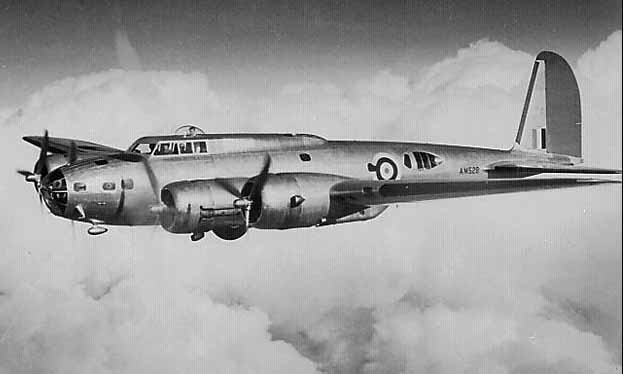 The Boeing B-17C was hastily placed in frontline service with the RAF as the Fortress Mk I, but it was not ready for combat. The guns froze in flight and bombing accuracy was poor, and it was withdrawn from service. In 1940, thirty-eight B-17Cs were produced of which twenty B-17Cs were delivered to the RAF as Fortress I trainers. However, they were hastily thrown into combat with defensive armament that was inadequate. The 0.50 caliber machine-guns froze at high altitude, there were oxygen problems and bombing accuracy was very poor with most of the bombs missing their targets. Boeing rectified these problems with the B-17D and added self-sealing tanks, additional crew armor, engine nacelle cowl flaps and installed two additional 0.30 caliber machine guns. The eighteen remaining B-17Cs were converted to B-17Ds. However, after the bombing of Pearl Harbor, many B-17s were destroyed or lost through attrition. Pacific units were complaining and it became obvious that something had to be done.13 |
|
In September of 1941, the B-17E 'big ass' model appeared with an extensively modified empennage. Gone was the shark fin tail. It was replaced with a great dorsal fin that rose just aft of the radio operator's position, creating a sturdier tail. The stronger tail came in handy when one B-17F, the "All American," had its tail clipped after a collision with a Messerschmitt Bf 109. |
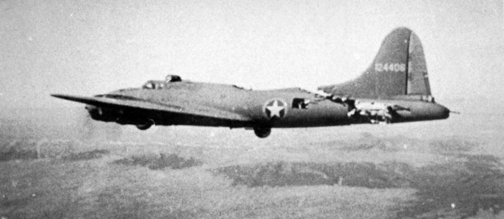 A Wing and a Prayer |
|
Along with the new tail, the E models featured a deadly stinger of two 0.50-caliber machine guns in the tail to cover a previous defensive blind spot. The B-17E also was equipped with a remote controlled belly turret that held two more 0.50s. All guns were changed to 0.50s except in the nose. 14 The B-17E was lengthened to 73 feet 10 inches (22.5 m) to accommodate the new defensive tail position. Top speed was 317 mph (510 km/h), it could cruise at over 200 mph (321 km/h) with 4,000 lb (1814 kg) of bombs, and the crew was increased from nine to ten members. The additional equipment made the aircraft seven tons heavier than the original Model 299. A total of 512 B-17Es were built.
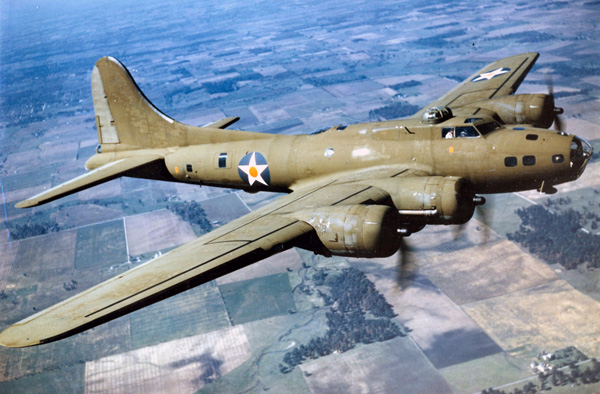 The Boeing B-17E was the 'big ass' model. The Pearl Harbor attack of December 7, 1941, finally brought the United States into the war and production of the B-17 rapidly increased. By July 1942, the US began forming the Eighth Air Force in Britain, equipped with B-17Es. On August 17, 1942, eighteen United States Army Air Force (USAAF) B-17s carried out a bombing raid on the railway yards at Rouen in France. Production of the B-17F was undertaken by Boeing, Vega and Douglas, the BVDs as they were called (the same abbreviation as the underwear company), but new modifications were taking their toll in airspeed. There were more than four hundred modifications on the B-17F. The only noticeable outside difference was the full blown Plexiglass nose. The B-17F, now armed with eleven 0.50-cal. guns, could only reach 299 mph (481 km/h) and the landing speed was up to 90 mph (144 km/h)! Service ceiling was 37,500 ft. (11,430 m) and range 2,880 miles (4,634 km). It took twenty-five and a half minutes to climb to 20,000 ft. (6,096 m). The BVD companies produced 3,400 B-17Fs.
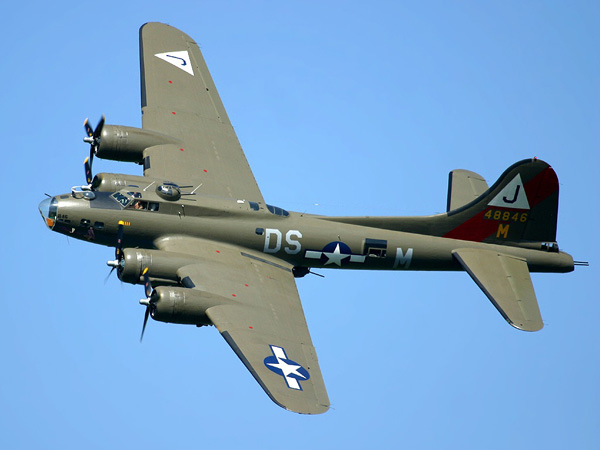 The B-17F model can be distinguished from the E and G by the lack of superstructure supporting the Plexiglas nose dome. On January 27, 1943, B-17s of the USAAF made their first attacks on Germany at the port of Wilhelmshaven. The attack was carried out by the 91st, 303rd, 305th and 306th Bomb Groups. Initially, casualties were very high because they attacked during daylight hours to achieve greater accuracy. Also proper formation flying, to enable a group of airplanes to defend each other with crossfire, (the legendary box formation) had not yet been formulated. Also the B-17F lacked adequate defense against a head-on attack. In head-on attacks, Luftwaffe fighters would porpoise towards the B-17, beginning with a slight dive and then coming up and raking across the underbelly of the airplane and repeating this maneuver against bombers bringing up the rear. This tactic relegated the upper turret, waist and tail guns as ineffective.15 In March 1943, some relief was obtained when the P-47 Thunderbolt showed up. The P-47 could escort the bombers partially towards their targets and meet them again on the return trip. But Messerschmitt Bf 109s and Focke-Wulf Fw 190s waited for the bombers until their escorts turned back. On October 19, 1943 during the second raid on Schweinfurt, the Luftwaffe shot down 60 and damaged 138 of the 291 B-17s dispatched, with a loss of 650 airmen. And on March 6, 1944 during a raid on Berlin, 69 B-17s were lost along with 17 fighters with a loss of 701 men. However, the Luftwaffe lost 160 aircraft. Despite such losses for the Eighth Air Force, not one mission ever turned back.16 By September 1943, the Flying Fortress showed its final shape during firepower tests on the XB-40, a modified B-17F with the advantage of a "chin" turret. The Bendix turret held two 0.50 caliber guns, which increased the armament to thirteen guns. The XB-40 didn't carry any bombs but was heavily armed and had extra armor for the crew. It was much heavier than the F Model and also slower. The idea was to escort the bombers during raids, but after the bombers released their loads, the XB-40 could not maintain formation and the bomb squads would have to slow down. The XB-40 was abandoned, but the Bendix chin turret was adapted to the B-17G. The B-17G was produced in greater numbers than any other single model and more B-17Gs were lost than any other model. The most obvious difference was the installation of the Bendix chin turret installed under the nose. With the turret under the nose, the view through the Plexiglass nose was now unobstructed for the gunner. The chin turret also had no adverse effect on the aerodynamics of the airplane, and it finally produced the protection that was needed against head-on attacks. Another major change was the installation of the Cheyenne tail turret. The gun had a larger field of fire and the ring-and-bead site was replaced with a reflector site. On the late G models, the waist gunner windows were staggered so the gunners wouldn't get in each other's way. The radio operator's gun on the upper hatch was eliminated since it was considered of low value, because of its poor vantage point. Gradually, production of the B-17 was left solely to Vega and Douglas in California as Boeing eased out of building the B-17 to make room for B-29 Superfortress production lines.17 In all, there were 8,680 B-17Gs built by Boeing, Vega, and Douglas to make it the largest production variation. 18 When the G models appeared, it was about the same time as when the North American P-51 Mustang came onto the scene. It was a game changer when Mustangs could escort bombers all the way to Germany and back. Starting in late 1943, P-51s were used to escort the USAAF's Eighth Air Force bombers, which was the beginning of the Allied dominance of the skies over Germany. With overwhelming numbers, Allied fighters were able to inundate the German Luftwaffe making the defeat of Germany a foregone conclusion.
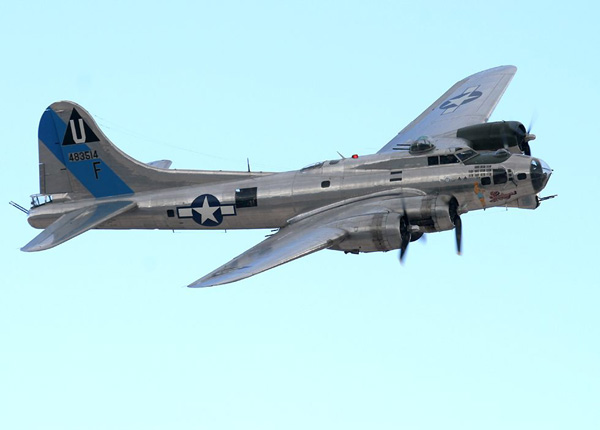 The B-17G introduced new fire power in the form of the Bendix chin turret. On 19 July 1943, US B-17s and B-24 Liberators carried out the first bombing raid on Rome. US bombing in Europe reached its high point in February 1945 with a 1,000-bomber raid on Berlin, escorted by 400 fighters, and the Dresden raid (alongside RAF Lancasters) which caused a massive fire storm to sweep the city. Meanwhile, B-17s were also helping to win the war against Japan, although by mid-1944 the larger Boeing B-29 had begun to take over the major strategic bombing missions in the Pacific theater. Following the first Model 299, the Air Corps purchased 12,725 B-17 type aircraft, of which a few served with Royal Air Force Coastal Command and the United States Navy for patrol, air-sea rescue, antisubmarine and other duties. Cargo conversions of the B-17 were known as the XC-108. |
| Boeing B-17 Flying Fortress Specifications | |||
|---|---|---|---|
| Model: | B-17E | B-17F | B-17G |
| Dimensions: | |||
| Wing span: | 103 ft. 9 in (31.6 m) | 103 ft. 9 in (31.6 m) | 103 ft. 9 in (31.6 m) |
| Length: | 74 ft. 1.5 in (22.5 m) | 74 ft. 8.9 in (22.8 m) | 74 ft. 4 in (22.6 m) |
| Height: | 19 ft. 2.4 in (5.9 m) | 19 ft. 2.4 in (5.9 m) | 19 ft. 1 in (5.8 m) |
| Wing Area: | 1,420 sq ft (132 sq m) | 1,420 sq ft (132 sq m) | 1,420 sq ft (132 sq m) |
| Weights: | |||
| Empty: | 33,279 lb (15,095 kg) | 35,728 lb (16,205 kg) | 36,135 lb (16,391 kg) |
| Loaded: | 40,260 lb (18,261 kg) | 40,260 lb (18,261 kg) | 54,000 lb (24,500 kg) |
| Maximum Take-off: | 48,726 lb (22,101 kg) | 48,720 lb (22,099 kg) | 65,500 lb (29,710 kg) |
| Performance: | |||
| Maximum Speed: | 318 mph (511 km/h) at 25,000 ft (7,625 m) |
325 mph (523 km/h) at 25,000 ft (7,625 m) |
287 mph (462 km/h) at 25,000 ft (7,625 m) |
| Cruise Speed: | 160 mph (257 km/h) | 160 mph (257 km/h) | 182 mph (293 km/h) |
| Service Ceiling: | 30,000 ft (9,144 m) | 30,000 ft (9,144 m) | 35,600 ft (10,850 m) |
| Normal Range: | 2,000 miles (3,219 km) with 6,000 lb (2,722 kg) bomb load @ 220 mph (352 km/h) @ 25,000 ft (7,625 m) | 2,000 miles (3,219 km) with 6,000 lb (2,722 kg) bomb load @ 220 mph (352 km/h) @ 25,000 ft (7,625 m) | 2,000 miles (3,219 km) with 6,000 lb (2,722 kg) bomb load @ 220 mph (352 km/h) @ 25,000 ft (7,625 m) |
| Powerplant: |
Four 1,200 hp (895 kW) Wright R-1820-65 Cyclones 9 cyl. air-cooled single-row radial engines with GE Type B-2 turbo-superchargers. |
Four 1,200 hp (895 kW) Wright R-1820-97 Cyclones 9 cyl. air-cooled single-row radial engines with GE Type B-2 turbo-superchargers. |
Four 1,200 hp (895 kW) Wright R-1820-97 Cyclones 9 cyl. air-cooled single-row radial engines with GE Type B-22 turbo-superchargers. |
| Armament: |
Eleven 50-cal. machine-guns plus a maximum of 17,600 lb (7,983 kg) of bombs. Normal bomb load 6,000 lbs (2,724 kg). Largest bomb type carried was 2,000 lb (908 kg). |
Thirteen 50-cal. machine-guns plus a maximum of 17,600 lb (7,983 kg) of bombs. Normal bomb load 6,000 lbs (2,724 kg). Largest bomb type carried was 2,000 lb (908 kg). |
Thirteen 50-cal. machine-guns plus a maximum of 17,600 lb (7,983 kg) of bombs. Normal bomb load 6,000 lbs (2,724 kg). Largest bomb type carried was 2,000 lb (908 kg). |
Endnotes:
|
1. Michael J.H. Taylor and John W.R. Taylor, ed. Encyclopedia of Aircraft. New York; G.P. Putnam's Sons., 1978. 40. 2. Chris Chant. From 1914 To The Present Day, The World's Great Bombers. Edison, NJ; Chartwell Books, Inc., 2005. 90. 3. David Mondey. A Concise Guide to American Aircraft of World War II. New York; Smithmark Publishers, 1996. 20. 4. Kenneth Munson. Bombers Between the Wars, 1919-1939. New York: The MacMillan Company, 1970. 160. 5. Lloyd S. Jones. U.S. Bombers. Fallbrook, California: Aero Publishers, 1974. 51. 6. Kenneth Munson. Bombers Between the Wars, 1939-1945. London: Blandford Press, 1969. 151. 7. John T. Correll. The Air Force on the Eve of World War II. Air Force Magazine. October 2007. 8. Page Shamburger and Joe Christy. Command the Horizon, A Pictorial History of Aviation. New York: Castle Books, 1968. 291. 9. William Green. Famous Bombers of the Second World war. Garden City, New York; Doubleday & Company, 1975. 48. 10. Franklin D. Roosevelt: Message to Congress on Appropriations for National Defense. January 12, 1939. 11. Benjamin D. Foulois and C.V. Glines. From the Wrights to the Astronauts, The memoirs of Major General Benjamin D. Foulois New York: McGraw-Hill Book Company, 1968. 232. 12. Herbert M. Mason, Jr. The United States Air Force, A Turbulent History. New York: Mason Charter, 1976. 119. 13. Charles D. Thompson. Aircraft in Profile, Volume 4; Boeing B-17E & F Flying Fortress. Garden City, New York: Doubleday & Company, 1968. 3. 14. Enzo Angelucci, Paolo Matricardi and Pierluigi Pint. Complete Book of World Combat Aircraft. Vercelli, Italy: White Star Publishers, 1988. 242. 15. Norman Fortier. An Ace Of The Eighth. New York: The Random House Publishing Group, 2003. 86. 15. Edward H. Sims. American Aces. New York: Ballatine Books, 1966. 18. 16. Howard Mingos, ed.The Aircraft Year Book for 1945. New York: Lanciar Publishers, Inc. 1945. 227. 17. Roger A. Freeman. Aircraft in Profile, Volume 9; Boeing B-17G Flying Fortress. Garden City, New York: Doubleday & Company, 1971. 1. |
©Larry Dwyer. The Aviation History Online Museum.
All rights reserved.
Created September 8, 1996. Updated September 1, 2024.










